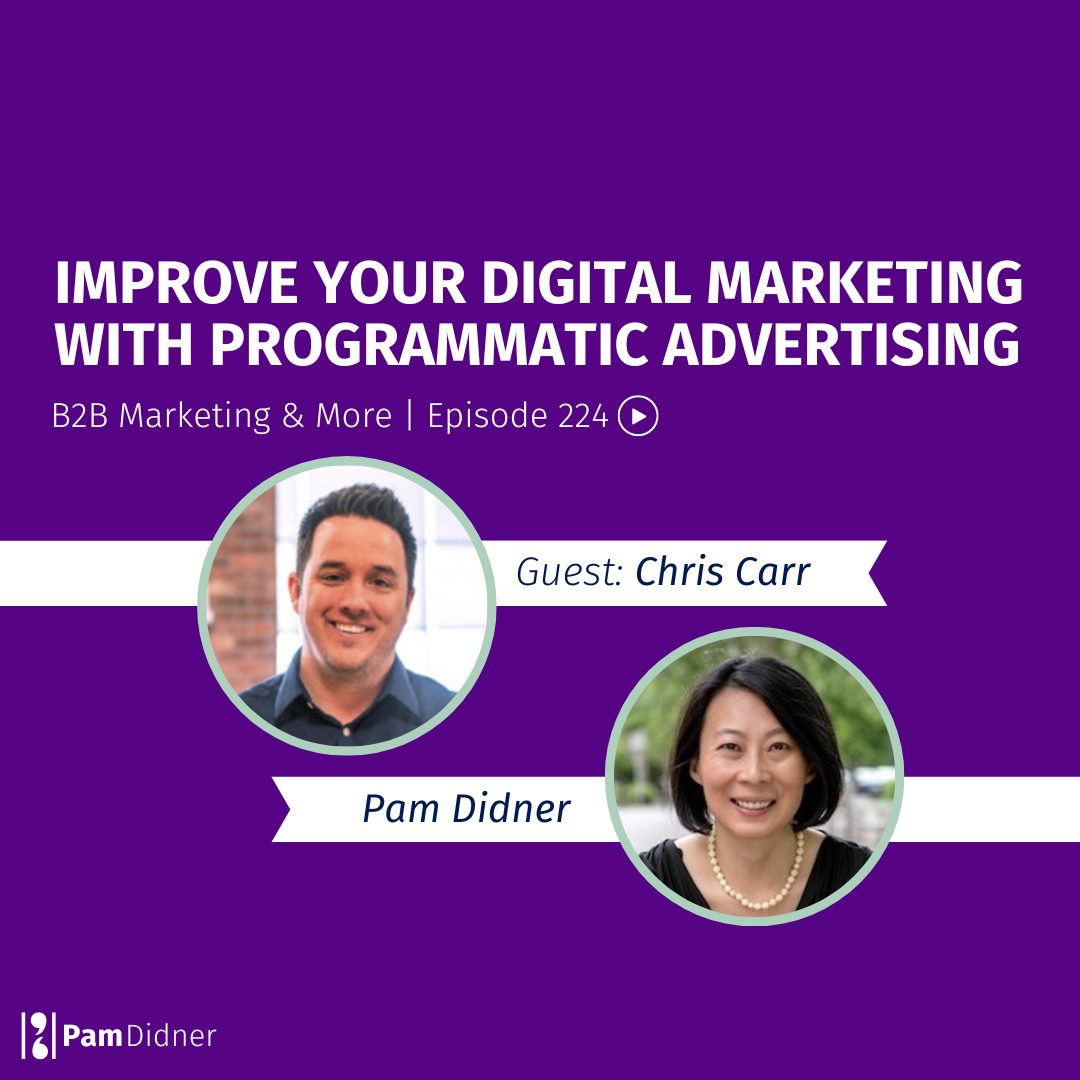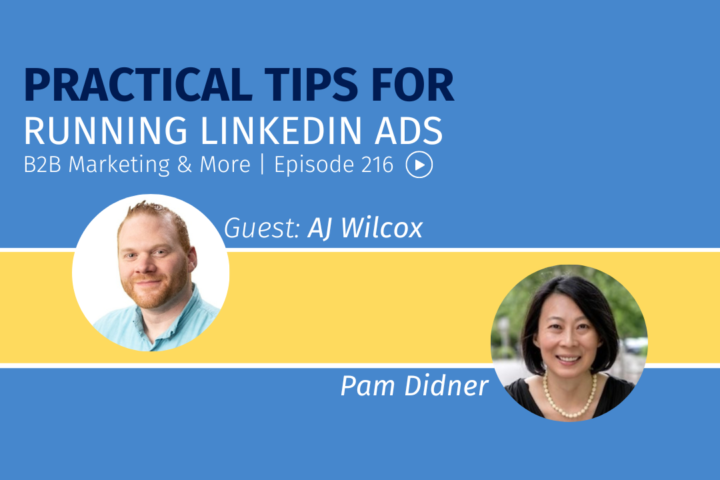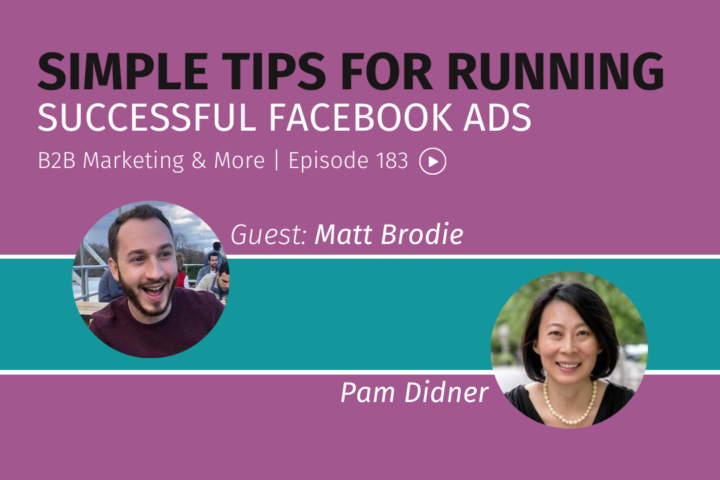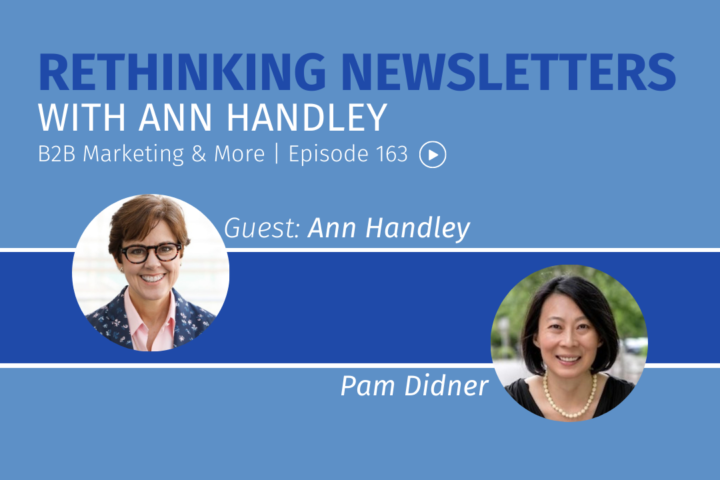
Welcome to another episode of B2B Marketing & More with Pam. My guest today is Chris Carr, founder and CEO of the digital marketing agency Farotech.
Tune in to learn how to boost content promotion, and improve your digital marketing with programmatic advertising.
In this episode:
- Why are marketers struggling with digital marketing as a whole?
- What should marketers need to pay attention to in digital marketing?
- What are some missing pieces of a content strategy?
- Since promotion is so important, should people invest in paid advertising efforts?
- What are some key elements of paid content promotion plan?
- How can marketers use organic outreach?
- What is programmatic advertising?
- What key questions should marketers ask their agencies about programmatic ads?
Quotes from the episode:
“Nine times out of 10, most companies, want to create awareness content, and they want it to close as soon as possible. They don’t understand that their client sometimes needs room to breathe. They need to engage with your marketing, brand, and messaging and decide on their timetable, not yours.”
“Programmatic [advertising] can do all of that firepower that LinkedIn does, but it does it on the open internet. So you could be on Forbes.com, you could be on CNN.com, you could be wherever, and if the targeting is right, only the people on your list are going to see those ads.”
—————
Enjoy the podcast? Subscribe to the show on your favorite podcast platform, leave a 5-star review, and subscribe to Apple Podcasts.
If you prefer watching a video, I also have a YouTube Channel; check it out and subscribe.
If you want to chat, contact me on any social media channels or email me at hello@pamdidner.com. You can also join my Facebook community: Build Your Marketing Skills to Get Ahead.
To expand your knowledge about technology and how to improve your digital marketing with programmatic advertising, check out some of my previous podcast episodes, blog posts, and video.
Podcast episodes
Practical Tips for Running LinkedIn Ads
Simple Tips For Running Successful Facebook Ads
Data-First Marketing: A Modern Approach to Data-Driven Business
Blog post
Making Martech Stack Manageable – 3 Things To Know
AI for Sales and Marketing: Q&A with Streamly
Video
How to Implement AI into Your Marketing for your Business | Tools & Strategy Pitch
TRANSCRIPT
Hey! A big hello from Raleigh, North Carolina. Yay. Another episode of B2B Marketing and More with Pam. And I have a very special guest today: Chris Carr. We will talk about digital marketing and content promotion, which is very important. So Chris, welcome to my show.
Chris Carr: Yeah, thanks. Thanks for having me. This is great.
Pam Didner: I know that you are the founder and the CEO of Farotech. Can you also share with my listeners and the people watching the video what your company does? And then we’ll take it from there.
Chris Carr: Sure. So I started Farotech around 21 years ago. We’re a digital marketing agency. It’s a little bit less than 50 people. And over the last 21 years, we built what we call our unique process. And essentially, what that is, we help companies build systems that generate leads, nurture leads into clients, and then convert those clients into raving fans of your brand, your mission, and your values.
Essentially, we’re trying to help companies look at the technology curve that’s coming ahead and realize, “Hey, you know what? It’s no longer a one-man job or a one-person job anymore. And so if you’re gonna scale, you wanna find partners that will help you do that effectively, minimize the mistakes hundreds of companies make, and double down and scale effectively.”
Pam Didner: If I am not mistaken, you wrote a playbook, Digital Marketing Playbook. Can you give us like three takeaways from that specific playbook?
Chris Carr: Well, there are a lot of takeaways. I go through our entire unique process, everything from our gap assessment–which is our discovery methodology. All the core things from buyer personas to usability conversion analysis to SEO, social media, paid advertising, lead nurturing, video development, and analytics. It’s a fully comprehensive marketing approach, but the reason why we call it our unique process is we have a certain twist that we’ve done.
So we’ve scoured the web and looked for some of the best thought leaders in each critical area. We’ve married that with some methodologies we’ve learned from HubSpot and other technologies we’ve been learning from AI and married that even more with sales.
What we try to do is we try to put that one, we call that person “Marketing Mary”–it’s a HubSpot term–but we try to put that person and make them the quarterback of the plan. But we have a strategy that they’re gonna implement over the next three to five years. And a lot of it comes down to math. And so what I say with this is that I need to know your goals. And so if I know, say, it’s a financial goal of $20 million, if it’s a financial goal to increase by 20 million, what I need to be able to do is I need to say, how many sales does it take to get to 20 million?
Pam Didner: Right. You reverse engineer.
Chris Carr: Yes. How many leads does it take to get a sale? And how many visits does it take to get a lead?
And then, how many visits does it take to reach your goals? And so a lot of what we’re trying to do is to figure out the math behind what it takes to get one sale, and then how do we duplicate that effort?
Pam Didner: Yeah, I like that. This sounds very easy, but the devil is in the detail. It is very hard, and you must think through the whole process. And that also involves technology. When you are working with many clients doing that, what are some of the technologies or the platforms are critically essential to kind of look into this whole, what you call a unique process that they must have?
Chris Carr: I think that one of the things that we put as the spine of our approach is the use of HubSpot. We recommend a marketing automation platform. We’ve tried them all. We like HubSpot. Sometimes you can even say Salesforce plus HubSpot. One of those two systems is sort of in the background. And then what you want to ensure is that it seamlessly integrates with your sales CRM. And then ideally, maybe even with your service deck and customer service deck and things like that.
What you’re eventually trying to do is try to marry all of your systems, so they speak the same language to each platform.
Pam Didner: I 100% agree with you. I know many people use Zapiers, but from my perspective, API to have a data flow from one system to another is probably the best way to do it. I agree.
Chris Carr: I can’t prove this, but I even think that the companies that build these platforms, they could make it better for APIs to work, but then they kind of say, “Hey, you know what? I might be shooting myself in the foot when I make it so easy for other things…”
Pam Didner: I understand, hear you, and think you are correct. So another question I would like to ask you is how much digital marketing is important. The backing integration allows the system to have a data point flow from one to another, which is supercritical. And there is another missing piece in terms of digital marketing that is important. It’s content, right? Content plays a huge role, especially in B2B marketing and especially on the sales side.
They can use the content as a conversation opener to drive the conversation.
They can also use the content to accelerate and continuously engage with the prospect. Giving that content plays a huge role in digital marketing strategy and outreach. What are some of the missing pieces that you have seen from your clients when they put the content strategy together? There are always some critical missing elements.
Chris Carr: Big time. Big time. And you know, this is probably one of my biggest calling cards. Nine times out of 10, most companies, want to create awareness content, and they want it to close as soon as humanly possible. They don’t understand that their client sometimes needs room to breathe. They need to engage with your marketing, brand, and messaging and decide on their timetable, not yours.
And so, so many companies just want us to bring traffic. Hoping that it’s a numbers game and that it’s gonna close. And the reality is, I was just, It’s funny, I just launched a podcast with Andy Crestadino, whom I think, you know.
Pam Didner: I love Andy. So you, you just launched a podcast with him. Yay!
Chris Carr: I was saying to Andy that we run into this all the time. It’s like you have an extremely leaky bucket, and the answer to that is more water, and I’m like, “No, it doesn’t work like that.”
Pam Didner: You have to find where the leaks are, and then you have to pack it.
Chris Carr: Yeah. First, we need to have a really strong message, all right? We need to figure out your story and your story to each of the personas you’re trying to reach. And then, we have to ensure that your website is clear and concise and can say that and speak that to your target audiences. Because if I drive traffic there, depending on the size of your viable audience, I only might get one bite of the apple. And so if I win and I drive traffic, and your messaging is terrible, you lost a really good opportunity because they might not come back because they think, “Oh, I know who they are.” So we gotta lock down. We gotta figure out your story. We gotta get that right first.
Then as we apply the unique process, we’re gonna figure out what’s working and what’s not. We’re gonna figure out what to double down on, what to dismiss and what to invest more time in. As you said, what are the big holes? This is because everybody wants sales right out of the gate and doesn’t understand that they are the problem.
Pam Didner: I hear you. Many marketers, or even salespeople, understand that the purchasing cycle is long for many products, especially on the B2B side.
I would say marketers and sales professionals understand that they also get pressured by management a lot of time, right? ABC–always be closing. Always be closing, right? And they want to shorten that time.
But I think it’s also important for marketers and salespeople to educate their management. It does take time, especially for the opportunities that were a bigger dollar. And I also agree with you in terms of a lot of people that, that they focus on creating content, creating content, and I think that’s important. But to your point, the messaging, which is the foundation of the content you create, is critical.
And, speaking of messaging, I also have a messaging framework that I wrote and, uh, as a DYI. So if you search for messaging framework at pamdidner.com, that template will come up is a DIY template.
You can use it, but I agree with you, Chris, that the messaging part of it before you create any content or what is the messaging you want to articulate in terms of, uh, your product is supercritical and make that very clear on your website.
Chris Carr: Another tip, I would probably say this is, I kind of stole this from Larry Kim, is once you find your unicorn work hard to make baby unicorns. (Pam laughs) What happens here is that you’ve heard the expression like a one-hit-wonder. It is really hard to get that hit.
Pam Didner: To emulate that hit. Sometimes it’s just hard.
Chris Carr: Yeah. And like one of the things that’s interesting, so we have a convenience store in Philadelphia, and I think they’ve made it down to Raleigh, but it’s called Wawa. So that was born in our hometown, a convenience store that gets the little things right. And by the little things, it has all the essentials you need, but it has an incredibly good deli and sandwich store right there. The customer service is frictionless. It’s the same thing every single.
But because they just, they, they’re such a well-oiled machine and their coffee is so good and things like that, people put it into their daily lives. And so, everybody in our community gives them five to $7 daily.
Now my Wawa story is that Wawa has been around for almost 30 years, and what they did was, this is a very similar story to Chick-fil-A as well, but what they did was they had these small little convenience stores. Everybody thought, “Hey, I wonder when Wawa will be national, and they’ll take over the world?” And then, all of a sudden, they stopped making the convenience stores, and they knocked them all down. And then they made Super Wawas. And the Super Wawas are twice the size of the convenience store. And very, very cheap gas.
Pam Didner: That’s right.
Chris Carr: And the ones you’ve seen are probably the newer model. But Wawa was very smart in the aspect of, you know what, it’s very hard to scale.
Let’s try to figure it out. We know that we can get more out of your minimum viable audience. Rather than doing more expensive things, we knew that we could reach more people with this same product if we could do it better. It’s the same thing in content marketing. If you have a unicorn or a couple of hits, stop trying to make the next greatest hit. Milk it for all that its worth. Cut it into a thousand pieces. Multiply it. Microcontent use it to death because, you know what? Every time you try to make the next hit and the next hit and the next hit, you’re diluting what people know you for.
If Tony Robbins is right and its repetition is the mother of skill, every time they think that they know you, you change the tune, and then they never feel that. They never get, like, what is their angle? What is their tilt? What are they going after?
Pam Didner: I understand where you’re coming from, and I think, first of all, I love Wawas. I love the concept.
So I like that idea a lot, but I feel that you want to milk your cash cow as much as possible. But at some point, you still need to innovate. You still need to expand. You still probably need to modify your product. So the thing is, Chris, I feel that the companies need to fine-tune now, find that balance when they need to kind of build a new unicorn when they should continue to make a small unicorn.
Chris Carr: You can still be new, but it doesn’t have to be so separated from, you know, the core thing of what you sell. And so, you know, just be very cautious. Hey, you know what, before I try–and I, it’s the same thing as when you try to come out of the gate with five different products when it’s just—”like, I love the companies that are good at one thing first. Yeah. And then scale as opposed to trying to be all things to all.
Pam Didner: We morph our discussion from digital marketing to product. And from my perspective, that’s also important.
When I do the messaging framework with some clients, I always ask them, “Do you like your product? Do you think your product is solid?” You know, if the marketer’s answer is, “Well, I’m not sure about that,” that’s not going to sign. The product needs to be solid before you can create a solid and concrete, and unique, differentiated messaging framework. But if your product is not that great, my recommendation is to work on my product first or identify the key unique differentiator that we can talk about it.
With that being said, I have another question related to that. Let’s assume the product is solid and you also have good messaging. And you also have solid content. The website is great. The promotion becomes very, very important. And, uh, what is your take in terms of pay, uh, promotion versus organic? Is the pay promotion necessary?
Chris Carr: It depends on what niche you’re in.
When you think of something like Mark Schaeffer’s content shock or look at what we call the “content crisis,” there’s just so much content out there. I mean, it depends on what industry you’re in. I mean, there are very sleepy industries.
If you have found a way to be a niche of a niche and there’s a big enough community, you don’t need as much paid promotion. I would always start with your organic promotion anyway. I would think that you have earned it. There are three different levels of promotion you have earned, owned, and then paid. I don’t go to paid unless you’ve taken a stab at the other two because the other two are cheaper, and more can be more effective.
The devil’s in the details, you know. The earned people think if I do a really good job, people will know and come to me. That is not always true.
Pam Didner: Not always the truth. Yeah. That, that much I hundred per cent agree with you. I realized that much later. I have come to realize that the paid is essential. And I told my clients that, but I agree with you. Initially, I told them that your earned and your owned needs to be pretty solid. And once you get to the point that you want to increase exponentially, the pay will get you there.
Chris Carr: I would agree. I would agree; sometimes, it is much as 99% more expensive than the other two approaches. But it’s faster, commolates more targeted, commolates more effective. And so assuming you have a good program set up, in other words, your campaign set up effectively will probably reap bigger or faster rewards. The problem is, is it doesn’t compound.
So in your model, you have to know I’m paying for my clients. If you work more on earned and owned, the ability for it to compound is significantly better. What I like is something called programmatic advertising. People always ask me, “What’s better? Uh, Google display,” or, you know, basically Google ads, social media ads, or programmatic.
Pam Didner: Is a pay search part of programmatic ads? Another form?
Chris Carr: Not search. You know, in other words, it doesn’t control what comes from a Google search; but what it does is the targeting is second to none. So you know how we all love LinkedIn? So if you advertise on LinkedIn, I can go, and I can pick; I want these companies with this business title in this region. Literally down to the person’s name. You’re like, “Oh, that’s awesome!” The problem is that people don’t live on LinkedIn all day long. So you only get them when they’re on LinkedIn.
Programmatic can do all of that firepower that LinkedIn does, but it does it on the open internet. Yeah. So you could be on Forbes.com, you could be on CNN.com, you could be wherever, and if the targeting is right, only the people on your list are going to see those ads.
The other thing it does with AI technology is auto-bids for you.
So it’s not like you have a manual person moving the numbers the same way we do when we do campaigns manually. And then, the reach can hit them in display advertising, native advertising, CTV, podcast apps, and so on. And the geo-targeting is incredible. I think, finally, the other part is what’s called Content AI. And what content AI does is it knows what you’re reading on other people’s websites and will target you based on things you’ve read in other places because the open internet is so big.
Pam Didner: Similar ads follow you for the next five to seven days. That’s very much a programmatic ad.
Chris Carr: It’s targeting you from data outside of first-party data. So Nielsen and all these other companies have been targeting you since you were born.
Pam Didner: I know it’s called big advertising. Brother is watching
Chris Carr: Yeah. And it’s different. It’s very different from the privacy things that are taking a whack from, like Facebook and Apple privacy thing.
Pam Didner: The only thing I want to caution my listener, I agree with everything you said, and in terms of if you do paid ads on Facebook or any social media channel, it tends to limit it in that specific platform. That doesn’t mean it’s not effective. The drawback, just like you said, is that the person needs to be on the platforms to see your ads or whatnot.
The key thing I have discovered about programmatic ads is that you need a continuous budget. This is not something that you can run and stop, run and stop. This is not something you run for like a quarter or two and then you can stop. You need quite a bit of budget over some time to see the effectiveness of it.
Chris Carr: Absolutely.
Pam Didner: At the same time, you know, just like you said, the backend needs to be connected, that you can see in terms of the ads that drive traffic to your website and in terms of how you qualify that leads and the move on down to this, uh, the sales funnel that you need to have a backend integrated to be able to see that and then to quantify your contribution in terms of the sales, the pay contribution to sales. So, everything is kind of integrated, but I hear you. But at the same time, I want to caution the listeners. You do need a budget if you want to run this in a very successful manner.
Chris Carr: If you’re standalone, Ii you’re not one of our retainer clients, and you’re just doing ads with this, we don’t even. You have a minimum of $5,000 a month, which is the bare minimum.
Pam Didner: You need more than that. (Both laugh) That’s like, like, a drop in the bucket. It doesn’t; it’s like literally a drop. Okay. Very, very good. We talked about a lot of things today. Starting with digital marketing, we also talk about the business model and solid product and high-quality product is essential in the foundation of marketing, down to digital marketing needs to work very well. Pay plays a huge role. I agree with you. Chris, thank you so much for coming to my show. It was wonderful talking to you and sharing your insight.
Chris Carr: Yeah, thank you very much for having me. This is a wonderful show. I’m a fan.
Pam Didner: Take care. Bye bye!



